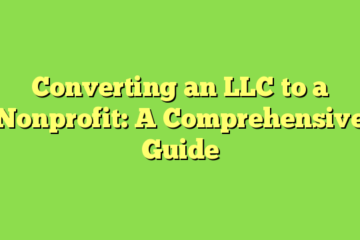If you’re the sole owner of a Limited Liability Company (LLC) and want to bring in additional members, you’ll need to change your single-member LLC to a multi-member structure. This process is essential to ensure that your business remains compliant with legal requirements and that the rights and responsibilities of all members are clearly defined.
In this comprehensive guide, we’ll walk you through the steps to successfully transition from a single-member LLC to a multi-member LLC, including key considerations, benefits, and potential challenges.
Understanding the Differences: Single-Member vs. Multi-Member LLC
Before we delve into the process, it’s essential to understand the key differences between a single-member LLC and a multi-member LLC.
Single-Member LLC
- Owned and managed by a single individual
- Considered a disregarded entity for tax purposes (unless you elect corporate tax treatment)
- Simpler formation and management process
- The owner is solely responsible for profits, losses, and liabilities
Multi-Member LLC
- Owned and managed by two or more individuals
- Taxed as a partnership by default (unless you elect corporate tax treatment)
- More complex formation and management process
- Profits, losses, and liabilities are shared among members based on predetermined ownership percentages
- Requires an operating agreement to define member roles, responsibilities, and decision-making processes
Steps to Change from a Single-Member LLC to a Multi-Member LLC
Changing your LLC’s structure involves the following simple steps to ensure compliance and protect the interests of all parties involved.
1. Review Your Current Operating Agreement
Start by reviewing your existing operating agreement, if you have one. This document outlines the procedures for admitting new members and making changes to the LLC’s structure. If your operating agreement doesn’t address this process, you’ll need to create one that includes provisions for adding new members.
2. Obtain Consent from the Existing Member
As the sole member of your single-member LLC, you’ll need to provide written consent to admit new members and convert the LLC to a multi-member structure. This step is crucial to avoid future disputes and ensure a smooth transition.
3. Identify and Bring in New Members
Identify the individuals or entities you want to bring in as new members. This could include business partners, investors, or employees to whom you want to grant ownership stakes.
4. Amend the Operating Agreement
Once you’ve identified the new members, you’ll need to amend your operating agreement to reflect the changes in membership. The amended agreement should clearly outline the rights, responsibilities, and obligations of each member, including:
- Ownership percentages
- Profit and loss allocation
- Management and decision-making processes
- Procedures for adding or removing members in the future
Ensure that the amended operating agreement complies with your state’s LLC laws and is legally binding.
5. Update State and Legal Documents
After amending your operating agreement, you’ll need to update your LLC’s formation documents with the state agency responsible for business entities, such as the Secretary of State or State Corporation Commission.
This typically involves filing articles of amendment or a similar document to reflect the change from a single-member to a multi-member LLC. Some states may also require you to file an annual member and manager list or provide other information about the new members.
6. Notify Relevant Agencies and Authorities
Inform relevant agencies and authorities about the change in your LLC’s structure. This includes:
- Updating your Employer Identification Number (EIN) with the IRS, as multi-member LLCs are taxed as partnerships by default
- Notifying state and local tax authorities, if applicable
- Updating business licenses, permits, and registrations to reflect the new multi-member structure
7. Update Taxation and Financial Accounts
Finally, you’ll need to update your LLC’s taxation and financial accounts to accommodate the new multi-member structure. This may involve:
- Filing a short-year tax return for the portion of the year when your LLC was a single-member entity
- Opening a new bank account and updating financial records to reflect the new ownership structure
- Ensuring proper tax withholding and reporting procedures for the multi-member LLC
Benefits of Changing to a Multi-Member LLC
While the process of changing from a single-member LLC to a multi-member LLC may seem daunting, it can offer several benefits for your business, including:
Increased Capital Infusion
Adding new members can bring in additional funds, enabling your LLC to finance growth, invest in assets, or expand operations.
Broader Network and Business Connections
New members contribute their network and connections, opening doors to potential clients, partnerships, and opportunities for your LLC.
Enhanced Decision-Making Capabilities
Additional perspectives and insights from new members can lead to better-informed decisions and strategic planning for your LLC’s success.
Reduced Individual Liability
All members of a multi-member LLC enjoy limited liability protection, shielding their personal assets from business debts and obligations.
Potential for Increased Profitability and Growth
Adding new members can increase resources, expertise, and opportunities, potentially driving higher profits and facilitating your LLC’s growth trajectory.
Tax Flexibility
Multi-member LLCs can be taxed as partnerships or corporations, providing potential tax advantages and flexibility in income distribution.
Sharing of Responsibilities
Multiple members allow for the division of management duties, reducing workload and promoting specialization.
Diverse Skills and Resources
Additional members bring varied expertise, knowledge, and resources, strengthening your LLC’s overall capabilities.
Potential Challenges and Considerations
While changing from a single-member LLC to a multi-member LLC can offer numerous benefits, it’s essential to be aware of potential challenges and considerations:
Complexity in Management and Decision-Making
With multiple members, decision-making processes can become more complex, requiring clear communication and well-defined procedures in the operating agreement.
Potential for Conflicts and Disputes
Introducing new members can lead to conflicts and disputes over management, profit distribution, or strategic direction. A well-crafted operating agreement can help mitigate these risks.
Tax Implications
Changing your LLC’s structure may have tax implications, such as the need to file short-year tax returns or adjust estimated tax payments. Consulting with a tax professional is recommended.
Compliance Requirements
Depending on your state’s laws, you may face additional compliance requirements, such as filing annual reports or maintaining specific records for multi-member LLCs.
Loss of Sole Control
As the sole member, you’ll need to be prepared to share control and decision-making authority with the new members.
By carefully considering these challenges and taking proactive measures to address them, you can increase the chances of a successful transition from a single-member LLC to a multi-member LLC.
Conclusion
Changing a single-member LLC to a multi-member structure is a significant decision that can have far-reaching implications for your business. By following the steps outlined in this guide and seeking professional advice when necessary, you can navigate the process smoothly and ensure that your LLC remains compliant with legal requirements.
Remember, the key to a successful transition lies in clear communication, well-defined agreements, and a thorough understanding of the benefits, challenges, and responsibilities associated with a multi-member LLC structure.

Alfie Wilson, Esq., is a legal content writer with expertise in business formation, criminal law, veterans disability, family law, DUI law, personal injury, animal welfare, and legal writing. He holds a J.D. from Emory University School of Law and has experience in appellate advocacy and regulatory matters. Alfie’s passion lies in breaking down complex legal topics for a non-lawyer audience. He currently writes for law firms and non-profits on various issues and resides in Arlington, Virginia.









